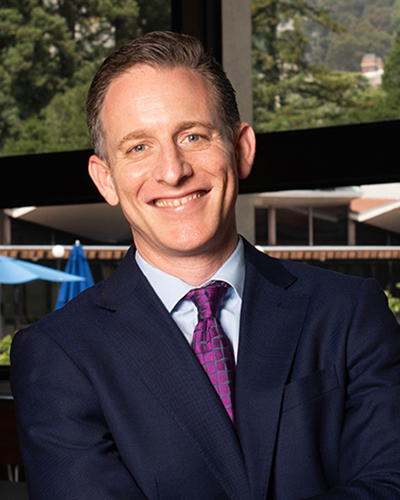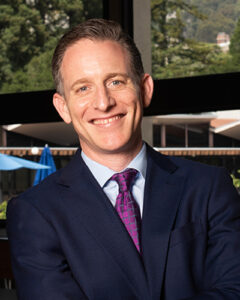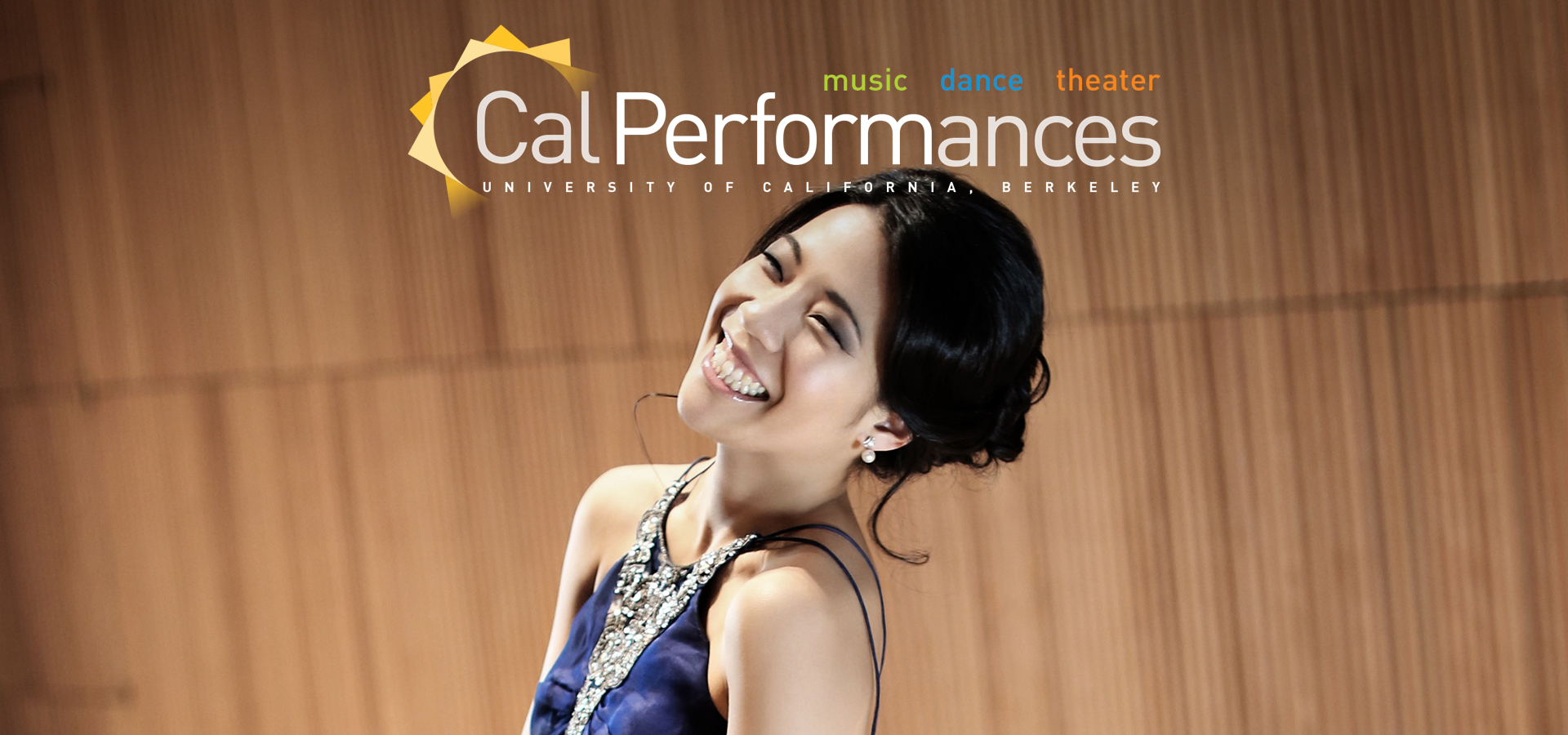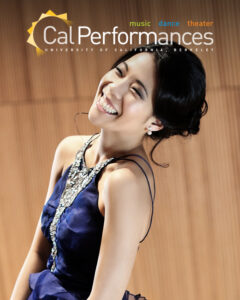Joyce Yang, piano
Sunday, January 22, 2023, 3pm
Hertz Hall
This performance is made possible, in part, by Amy Roth and Bob Epstein.
Run time for this performance is approximately 90 minutes including intermission.
From the Executive and Artistic Director

The new year gets off to a brilliant start this month with five performances featuring a host of popular returning artists. The renowned Monterey Jazz Festival on Tour celebrates 65 years of scintillating jazz-making when this year’s super-group hits Zellerbach Hall on January 18. Then, our focus shifts to classical music as we welcome the brilliant mezzo-soprano Joyce DiDonato and her partners Il Pomo d’Oro and conductor/violinist Zefira Valova with EDEN, their new program exploring the majesty, might, and mystery of the natural world. (By the way, the artists’ superb recording of this concert has been nominated for a Grammy Award this year.) The brilliant pianist Joyce Yang serves up a feast of music by composers including Tchaikovsky, Rachmaninoff, and Stravinsky, followed by a true season highlight, a special evening with chamber music superstars pianist Emanuel Ax, violinist Leonidas Kavakos, and cellist Yo-Yo Ma. Finally, the wonderful Takács Quartet returns for its second Cal Performances program this season, featuring music by Britten, Bartók, and Dvořák.
And that’s just the start of what we have planned for 2023. From now until May, when we close our season with the Bay Area premiere of Octavia E. Butler’s powerful and prescient opera Parable of the Sower and a long-awaited recital with international dramatic soprano sensation Nina Stemme—we have a calendar packed with the very best in the live performing arts.
And what a schedule! Dozens of remarkable events, including the return of the legendary Vienna Philharmonic Orchestra under conductor Christian Thielemann (in his Bay Area debut); the beloved Mark Morris Dance Group in Morris’ new The Look of Love: An Evening of Dance to the Music of Burt Bacharach; and the US premiere of revered South African artist William Kentridge’s astonishing new SIBYL (part of an exciting campus-wide residency with this singular artist).
Upcoming Illuminations programming will continue to take advantage of Cal Performances’ unique positioning as a vital part of the world’s top-ranked public university. Over the coming months, we’ll be engaging communities on and off campus to examine the evolution of tools such as musical instruments and electronics, the complex relationships between the creators and users of technology, the possibilities enabled by technology’s impact on the creative process, and questions raised by the growing role of artificial intelligence in our society.
This concept of “Human and Machine” has never been so pertinent to so many. Particularly over the course of the pandemic, the rapid expansion of technology’s role in improving communication and in helping us emotionally process unforeseen and, at times, extraordinarily difficult events has made a permanent mark on our human history. Throughout time, our reliance on technology to communicate has—for better and worse—influenced how we understand others as well as ourselves. During this Illuminations season, we will investigate how technology has contributed to our capacity for self-expression, as well as the potential dangers it may pose.
Some programs this season will bring joy and delight, and others will inspire reflection and stir debate. We are committed to presenting this wide range of artistic expression on our stages because of our faith in the performing arts’ power to promote empathy. And it is because of our audiences’ openness and curiosity that we have the privilege of bringing such thought-provoking, adventurous performances to our campus. The Cal Performances community wants the arts to engage in important conversations, and to bring us all together as we see and feel the world through the experiences of others.
Please make sure to check out our brochures and our website for complete information about upcoming events. We can’t wait to share all the details with you, in print and online.
Happy New Year from Cal Performances!
Jeremy Geffen
Executive and Artistic Director, Cal Performances
 The new year gets off to a brilliant start this month with five performances featuring a host of popular returning artists. The renowned Monterey Jazz Festival on Tour celebrates 65 years of scintillating jazz-making when this year’s super-group hits Zellerbach Hall on January 18. Then, our focus shifts to classical music as we welcome the brilliant mezzo-soprano Joyce DiDonato and her partners Il Pomo d’Oro and conductor/violinist Zefira Valova with EDEN, their new program exploring the majesty, might, and mystery of the natural world. (By the way, the artists’ superb recording of this concert has been nominated for a Grammy Award this year.) The brilliant pianist Joyce Yang serves up a feast of music by composers including Tchaikovsky, Rachmaninoff, and Stravinsky, followed by a true season highlight, a special evening with chamber music superstars pianist Emanuel Ax, violinist Leonidas Kavakos, and cellist Yo-Yo Ma. Finally, the wonderful Takács Quartet returns for its second Cal Performances program this season, featuring music by Britten, Bartók, and Dvořák.
The new year gets off to a brilliant start this month with five performances featuring a host of popular returning artists. The renowned Monterey Jazz Festival on Tour celebrates 65 years of scintillating jazz-making when this year’s super-group hits Zellerbach Hall on January 18. Then, our focus shifts to classical music as we welcome the brilliant mezzo-soprano Joyce DiDonato and her partners Il Pomo d’Oro and conductor/violinist Zefira Valova with EDEN, their new program exploring the majesty, might, and mystery of the natural world. (By the way, the artists’ superb recording of this concert has been nominated for a Grammy Award this year.) The brilliant pianist Joyce Yang serves up a feast of music by composers including Tchaikovsky, Rachmaninoff, and Stravinsky, followed by a true season highlight, a special evening with chamber music superstars pianist Emanuel Ax, violinist Leonidas Kavakos, and cellist Yo-Yo Ma. Finally, the wonderful Takács Quartet returns for its second Cal Performances program this season, featuring music by Britten, Bartók, and Dvořák.
And that’s just the start of what we have planned for 2023. From now until May, when we close our season with the Bay Area premiere of Octavia E. Butler’s powerful and prescient opera Parable of the Sower and a long-awaited recital with international dramatic soprano sensation Nina Stemme—we have a calendar packed with the very best in the live performing arts.
And what a schedule! Dozens of remarkable events, including the return of the legendary Vienna Philharmonic Orchestra under conductor Christian Thielemann (in his Bay Area debut); the beloved Mark Morris Dance Group in Morris’ new The Look of Love: An Evening of Dance to the Music of Burt Bacharach; and the US premiere of revered South African artist William Kentridge’s astonishing new SIBYL (part of an exciting campus-wide residency with this singular artist).
Upcoming Illuminations programming will continue to take advantage of Cal Performances’ unique positioning as a vital part of the world’s top-ranked public university. Over the coming months, we’ll be engaging communities on and off campus to examine the evolution of tools such as musical instruments and electronics, the complex relationships between the creators and users of technology, the possibilities enabled by technology’s impact on the creative process, and questions raised by the growing role of artificial intelligence in our society.
This concept of “Human and Machine” has never been so pertinent to so many. Particularly over the course of the pandemic, the rapid expansion of technology’s role in improving communication and in helping us emotionally process unforeseen and, at times, extraordinarily difficult events has made a permanent mark on our human history. Throughout time, our reliance on technology to communicate has—for better and worse—influenced how we understand others as well as ourselves. During this Illuminations season, we will investigate how technology has contributed to our capacity for self-expression, as well as the potential dangers it may pose.
Some programs this season will bring joy and delight, and others will inspire reflection and stir debate. We are committed to presenting this wide range of artistic expression on our stages because of our faith in the performing arts’ power to promote empathy. And it is because of our audiences’ openness and curiosity that we have the privilege of bringing such thought-provoking, adventurous performances to our campus. The Cal Performances community wants the arts to engage in important conversations, and to bring us all together as we see and feel the world through the experiences of others.
Please make sure to check out our brochures and our website for complete information about upcoming events. We can’t wait to share all the details with you, in print and online.
Happy New Year from Cal Performances!
Jeremy Geffen
Executive and Artistic Director, Cal Performances
About the Performance
Peter Ilyich Tchaikovsky
Selections from The Seasons, Op. 37a
At the end of 1875, two years before he came under the benefaction of Nadezhda von Meck, Tchaikovsky was making a scant living by teaching at the Moscow Conservatory and writing criticism for a local journal. To augment his income, he accepted a proposal from Nikolai Bernard, editor of the St. Petersburg monthly music magazine Nuvellist, to compose short piano pieces depicting each of the 12 months that would appear as features of the publication throughout the coming year. Though he was not fond of writing to specific deadlines nor of channeling his creativity into such miniature forms (he characterized his attitude about composing these pieces as “making musical pancakes”), Tchaikovsky needed the money, so he accepted the commission. The pieces were composed methodically throughout 1876—Tchaikovsky had his valet remind him of the due date every month, whereupon he would dash off a new piece in a single sitting—and published together the following year as The Months, Op. 37a. (Op. 37 was the 1876 Piano Sonata in G major.) The first British and American editions were issued, unaccountably, as The Seasons, and the work has always been known under that title in English-speaking lands. “It is a sure mark of Tchaikovsky’s professionalism, his sheer competence as a composer,” wrote David Brown in his study of the composer, “that he could discharge such a lowly task as this series of pieces so admirably.”
“January (By the Fireside)” evokes a comfortable domestic scene well protected from the windy gusts suggested by the arpeggiated flourishes in the central section. “February (Carnival)” uses a folk-like dance to depict the merriment of clowns. “April (Snowdrop)” is a spacious, lyrical evocation of early spring. “May (Starlight Nights)” is quiet and tender in its outer sections, but becomes more animated at its center. Though Tchaikovsky called “June” a Barcarolle, the traditional song of the Venetian gondoliers, this movement is one of the most nationalistic in the set, taking as its theme a soulful melody with the vaguely Oriental character so beloved by the Russian Romanticists. The high spirits elicited by the opening and closing sections of “August (Harvest)” are balanced by the movement’s placid central paragraph.
Sergei Rachmaninoff
Selections from 13 Preludes, Op. 32
The C-sharp minor Prelude, the second of the five Morceaux de Fantaisie (Op. 3) of 1892, was one of the most popular pieces Rachmaninoff ever wrote. It was played constantly during his lifetime in its piano original, as well as in versions for full orchestra, jazz band, and chamber ensembles. The number was requested so methodically on his recitals that he once claimed to loath the piece, though he never refused to play it. In 1942, the Walt Disney Studio in Hollywood featured it in Mickey’s Opry House, in which the immortal mouse was seen as a concert pianist performing the famous prelude. “I have heard my inescapable piece done marvelously by some of the best pianists, and murdered cruelly by amateurs,” the composer confided to the animator, “but never was I more stirred than by the performance of the great Maestro Mouse.” Encouraged by the continuing popularity of the C-sharp minor Prelude, Rachmaninoff returned to the form in 1901, and over the next two years produced the set of 10 preludes published in 1904 as his Op. 23. The model for these pieces was the 24 Preludes (Op. 28) of Chopin, a composer whose music was an integral part of Rachmaninoff’s concertizing and creative inspiration throughout his career. In 1910, Rachmaninoff completed the cycle of two-dozen pieces, one in each major and minor key (as were Chopin’s), with the 13 Preludes, Op. 32. These compact movements—Oskar von Riesemann called them “magnificently planned tone-pictures”—contain the full range of piano expression available to the vast resources of Rachmaninoff’s playing and compositional technique, from lyrical to dramatic, from martial to tender, from tragic to triumphant. An isolated prelude from 1917, in D minor, remained unpublished until after the composer’s death.
Prelude No. 10 from Op. 32 (B minor, Lento) contrasts the somber, elegiac plaint of its outer sections with the powerful, defiant gestures of its central passage. Prelude No. 12 (G-sharp minor, Allegro) drapes its melancholy main theme with fluttering, harp-like figurations. The brief, restless Prelude No. 1 (C major, Allegro vivace) launches ribbons of iridescent rising figurations from dramatic accented notes in the bass before closing with a surprising series of hymnal chords. The vernal Prelude No. 5 (G major, Moderato) is lyrical and consoling. Prelude No. 6 (F minor, Allegro appassionato) is the shortest and most turbulent of the Op. 32 set. Prelude No. 13 (D-flat major, Grave) is both a grand finale for Op. 32 and a summation of some of its musical elements.
Johann Sebastian Bach
Arranged for piano by Egon Petri
“Sheep May Safely Graze” from the Cantata Was mir behagt, ist nur di muntre Jagd (“The Lively Hunt Is All My Heart’s Desire”), BWV 208
After serving in positions as organist and church musician at Arnstadt and Mühlhausen from 1703 to 1708, Bach won a more prestigious job at the court of Weimar, presided over with iron will by the Saxon Duke Wilhelm Ernst, a stern religionist who insisted that his servants attend daily devotions and be always prepared to answer questions about the minutiae of the morning’s sermon. The Duke’s fervent Lutheranism did not, however, prevent his appreciating Bach’s genius as an organist and composer, so when authorities in Halle tried to win him away from Weimar in 1712, the ambitious musician leveraged a higher salary, a new title, and increased responsibilities for composing and preparing the court chapel’s vocal music from Wilhelm Ernst. In 1716, the court Kapellmeister, Johann Samuel Drese, died, and Bach, having largely performed Drese’s duties for the previous four years, expected to be named his successor. Local custom prevailed, however, and Drese’s son was appointed to the post. Bach, humiliated and disappointed, auditioned for an opening as director of instrumental music at the court of Anhalt-Cöthen in August 1717, and got the job. When Bach returned to Weimar the following month to settle his affairs and clear up the formalities surrounding his release, Wilhelm Ernst was so incensed at his celebrated organist’s defection (and by Bach’s gruff stubbornness) that he had him clapped into jail. A month was deemed long enough for this penal exercise to have its effect, and Bach was sent on his way in November “with notice of his unfavorable discharge.”
In February 1713, Wilhelm Ernst packed his court off for a visit to his Saxon kinsman Duke Christian in Weissenfels. For Christian’s birthday on February 23rd, Wilhelm had Bach compose a celebratory cantata to a libretto by Weimar court librarian Salomo Frank that invoked ancient mythological characters associated with the countryside and the hunt, Christian’s most ardent passion. Bach served up his new piece—Was mir behagt, ist nur di muntre Jagd (“The lively hunt is all my heart’s desire”)—at the birthday banquet on February 23rd, after Wilhelm and Christian and their guests had stimulated their appetites with an invigorating day in the saddle. The aria sung by Pales, the goddess of crops and pastures, to honor the Duke of Weissenfels is Bach’s most beloved pastorale: Sheep may safely graze where a caring shepherd guards them. Where a regent reigns well, we may feel secure and peaceful, and the country will prosper.
In 1944, when he was visiting professor at Cornell University, the German pianist Egon Petri made the present sensitive arrangement of “Sheep May Safely Graze.”
Aaron Jay Kernis
Un Bacio – A Kiss (Romance and Transfiguration) on themes by John Corigliano and Mark Adamo
Aaron Jay Kernis was born in Philadelphia in 1960 and started teaching himself piano and violin at age 12; he began composing soon thereafter. He took his professional training at the San Francisco Conservatory of Music (with John Adams), Manhattan School of Music (Elias Tanenbaum and Charles Wuorinen), Yale (Morton Subotnik, Bernard Rands, and, principally, Jacob Druckman), and the American Academy in Rome; he was appointed to the faculty of the Yale School of Music in 2003. Since the premiere of his Dream of the Morning Sky by the New York Philharmonic in 1983, Kernis has created an impressive catalog: significant scores for orchestra (three symphonies, New Era Dance, Invisible Mosaic III, Musica Celestis, a double concerto for guitar and violin, a concerto for English horn titled Colored Field); numerous compositions for varied chamber ensembles; pieces for piano, organ, and accordion; and many works for solo voices and for chorus. He has held extended residencies with the Saint Paul Chamber Orchestra, Minnesota Orchestra, Nashville Symphony, and Mannes College of Music. In 1998, Kernis won the Pulitzer Prize for his String Quartet No. 2, Musica Instrumentalis; his other honors include the University of Louisville’s prestigious Grawemeyer Award, a Grammy Award, the Stoeger Prize from the Chamber Music Society of Lincoln Center, a Guggenheim Fellowship, the Rome Prize, a grant from the NEA, and awards from BMI and ASCAP.
Kernis composed Un Bacio during the pandemic year of 2020, and it was premiered remotely to the Seattle Chamber Music Society on July 22nd by pianist Joyce Yang from Hoover, Alabama. Of it, Kernis wrote, “After attending [American composers] John Corigliano and Mark Adamo’s 25th anniversary party, I decided to fashion a work in their honor, presenting and intertwining their melodies and melodic fragments in the manner of Lisztian fantasies on other composers’ music. I did so to honor them as composers, friends and colleagues I respect immeasurably. Un Bacio includes excerpts, quotes from, and transformations of pieces by John Corigliano (The Red Violin: Chaconne; Circus Maximus; and ‘Postlude: Forever Young’ from Mr. Tambourine Man: Seven Poems of Bob Dylan) and Mark Adamo’s operas Little Women and Lysistrata.”
Igor Stravinsky
Arranged by Guido Agosti
“Danse infernale,” “Berceuse,” and “Finale” from The Firebird for Piano
Fireworks. There could not have been a more appropriate title for the work that launched the meteoric career of Igor Stravinsky. He wrote that glittering orchestral miniature in 1908, while still under the tutelage of Nikolai Rimsky-Korsakov, and it shows all the dazzling instrumental technique that the student had acquired from his teacher. Though the reception of Fireworks was cool when it was first performed at the Siloti Concerts in Saint Petersburg on February 6, 1909, there was one member of the audience who listened with heightened interest. Serge Diaghilev was forming his Ballet Russe company at just that time, and he recognized in Stravinsky a talent to be watched. Diaghilev approached the 27-year-old composer and requested orchestral transcriptions of short pieces by Chopin and Grieg that would be used in the first Parisian season of the Ballet Russe. Stravinsky did his work well and on time.
During that same winter, plans were beginning to stir in the creative wing of the Ballet Russe for a Russian folk ballet—something filled with legend and magic and fantasy. The composer Nikolai Tcherepnin was associated with the Ballet Russe at that time, and it was assumed that he would compose the music for a plot derived from several traditional Russian sources. However, Tcherepnin was given to inexplicable changes of mood and he was losing interest in ballet at the time, so he withdrew from the project. Diaghilev inquired whether Stravinsky had any interest in taking it over, and he agreed. The triumphant premiere of The Firebird in Paris on June 25, 1910, rocketed Stravinsky to international fame.
The story deals with the glittering Firebird and the evil ogre Kashchei, who captures maidens and turns men to stone if they enter his domain. Kashchei is immortal as long as his soul, which is preserved in the form of an egg in a casket, remains intact. The plot shows how Prince Ivan wanders into Kashchei’s garden in pursuit of the Firebird; he captures it and exacts a feather before letting it go. Ivan meets a group of Kashchei’s captive maidens and falls in love with one of them. The princesses return to Kashchei’s palace. Ivan breaks open the gates to follow them, but he is captured by the ogre’s guardian monsters. He waves the magic feather and the Firebird reappears to smash Kashchei’s vital egg; the ogre expires. All the captives are freed and Ivan and his Tsarevna are wed.
This virtuoso arrangement of excerpts from The Firebird is by the Italian pianist and teacher Guido Agosti, a student of Busoni and graduate of Bologna University and a faculty member of the Venice Conservatoire and Santa Cecilia Academy in Rome. The “Infernal Dance of King Kashchei” is the music depicting the madness engendered by the appearance of the Firebird at Kashchei’s court after the revelation to Ivan of the evil ogre’s vulnerability. The haunting “Berceuse” is heard when the thirteenth princess, the one of whom Ivan is enamored, succumbs to a sleep-charm that saves her from the terrible King while Ivan destroys Kashchei’s malevolent power. The broad, rising strains of the Finale confirm the life-force that had been threatened by Kashchei.
—©2023 Dr. Richard E. Rodda




